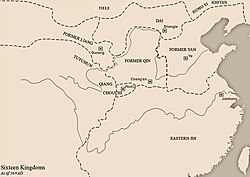Yan 燕 | |||||||||||||||
|---|---|---|---|---|---|---|---|---|---|---|---|---|---|---|---|
 Former Yan in 338 AD | |||||||||||||||
 Former Yan in 369 AD | |||||||||||||||
| Capital | Jicheng (棘城) (337–342) Longcheng (342–350) Jicheng (薊城) (350–357) Yecheng (357–370) | ||||||||||||||
| Government | Monarchy | ||||||||||||||
| Emperor | |||||||||||||||
• 337–348 | Murong Huang | ||||||||||||||
• 348–360 | Murong Jun | ||||||||||||||
• 360–370 | Murong Wei | ||||||||||||||
| History | |||||||||||||||
• Murong Huang's claim of princely title | 23 November 337[1][2] | ||||||||||||||
• Murong Jun's claim of imperial title | 4 January 353[3][4] | ||||||||||||||
• Fall of Yecheng | 11 December 370[5][6] | ||||||||||||||
• Disestablished | 370 | ||||||||||||||
| |||||||||||||||
| Today part of | China | ||||||||||||||
Yan, known in historiography as the Former Yan (Chinese: 前燕; pinyin: Qián Yān; 337–370), was a dynastic state of China ruled by the Murong clan of the Xianbei during the Sixteen Kingdoms period. From Liaoning, the Former Yan later conquered and ruled over Hebei, Shaanxi, Shandong and Henan at its peak. They were notably the first of several Xianbei states to have establish their rule over the Central Plains. The prefix of "Former" is used in historiography to distinguish them from the other Yan states that came after them such as Later Yan.
Initially, Murong Huang and his son Murong Jun claimed the Eastern Jin-created title "Prince of Yan", but subsequently, in 352, after seizing most of the former Later Zhao territory, Murong Jun would declare himself emperor, and after that point, the rulers of the Former Yan declared themselves "emperors". The Yan changed their capital from time to time, with their last capital, Ye being the most prestigious due to its status as a major population hub.